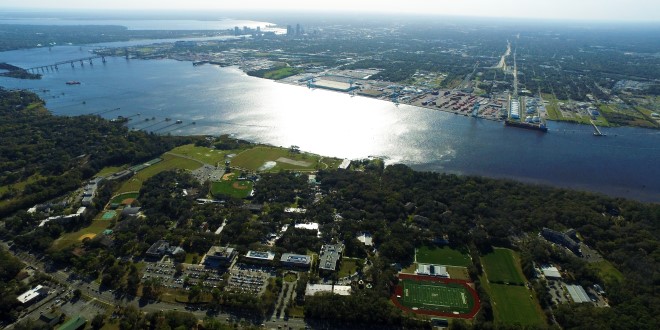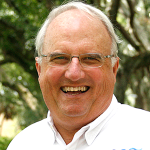Earth Day was on April 22nd, and we celebrated at Jacksonville University with a virtual fundraiser for our waterfront programs: rowing, sailing, the Marine Science Research Institute and OCEARCH. The event was a huge success. We thank our generous supporters. This event was unique in the way four very different programs came together around one common theme: water.
Water is so critical to life. Yet we take it for granted that we will always have water and plenty of it. Sort of like the St. Johns River. We just assume it will be there and available for us to use.
Recently, two separate incidences have occurred that directly impact our precious water resources. One was here in Jacksonville, and one was near Tampa. Both offer lessons we should learn.
The 7,025-ton, 416-foot barge Bridgeport began taking on water after grazing the Mayport jetties in bad weather on March 22. The barge was loaded with 14,000 tons of coal ash from Puerto Rico. It is still there about a mile south of the St. Johns River entrance. The barge was grounded in the sand to keep it from sinking. Salvage crews are working to unload the material and refloat the barge.
The coal ash that is on the barge is a potentially catastrophic environmental disaster sitting at the mouth of the St. Johns River. Coal ash is a catchall term used for material left from power plants that burn coal. It typically contains toxic residue riddled with arsenic, chromium, lead, mercury and other harmful chemicals. Make no mistake, coal ash is both hazardous and a waste product. But in the wisdom of the U.S. Environmental Protection Agency, with some help from the power plant and coal lobbyists, it is not classified as hazardous waste. It can be handled like household garbage.
That is how Puerto Rico’s coal ash can be shipped to Jacksonville, off loaded, and trucked to a landfill in Georgia. You can make construction material out of coal ash with the concept that it becomes roadbed fill and is covered with cement or asphalt. That keeps the toxic heavy metals from leaching out and getting into our water ways. JEA makes a similar product called EZBase.
But potential environmental disasters are one mistake or accident away.
That is what happened at Piney Point near Tampa Bay, where an abandoned phosphate plant’s waste water reservoir containing over 480 million gallons of water began to leak. It was first discovered in March. Workers began removing millions of gallons of polluted water from the reservoir each day to reduce pressure on its lined earthen walls. Concerns over a potential breach prompted more than 300 homes and businesses to be evacuated. It was feared that a 20-foot high wall of water might crash into nearby communities. Thankfully, no flood occurred.
However, to reduce the threat of the catastrophic damage, millions of gallons of untreated, but phosphate laden water were pumped into nearby Tampa Bay. Regretfully, this is not the first time such an “accident” has happened. Over the years, usually preceded by a hurricane or major rainfall event, the pond had reached capacity and threatened to overflow its banks. Each time, emergency measures had to be undertaken to avert a calamity.
The impact of the nutrient rich water being pumped into Tampa Bay is not known. Scientists are monitoring the situation to track the results. Again, the potential for a catastrophic disaster still exists in Tampa Bay.
Regretfully, these are not isolated incidents. Barges move daily up and down the St. Johns River, one accident away from a costly fiasco. And the St. Johns River basin has wastewater treatment ponds, maybe not loaded with phosphate-rich water, but loaded nevertheless with similar toxins, ready to unload and spill into the river.
When will we learn?
Glad you asked River Life
To what question in marine science do you wish you knew the answer?
There is so much we do not know. Someone once said, “We know what we know, but we don’t know what we don’t know.” About 20 years ago, then U.S. Secretary of Defense Donald Rumsfeld made a somewhat famous quote about “known knowns, known unknowns, and unknown unknowns.” Science is all about using what we know to discover what we don’t know. The marine world is full of unknown unknowns. But if I had a crystal ball with answers to future questions, I’d like to know the fate of all the plastics we are dumping into our oceans. Will it be as bad as we fear?
River Life runs the first Tuesday of each month in The Florida Times-Union. E-mail Quinton White, executive director of Jacksonville University’s Marine Science Research Institute, with questions about our waterways at qwhite@ju.edu. For more on the MSRI, visit ju.edu/msri.
 Wave Magazine Online Jacksonville University News Hub
Wave Magazine Online Jacksonville University News Hub

